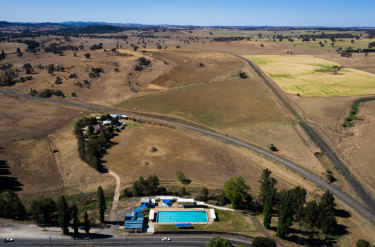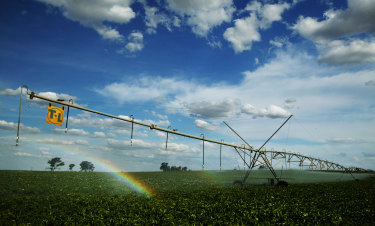One-tenth of groundwater users in breach of licences investigation finds
About one in 10 groundwater users are non-compliant, with one operator extracting the equivalent of 1200 Olympic swimming pools of water more than the licence allowed for, a pilot probe of NSW bores has found.
The Natural Resources Access Regulator inspected 397 water access licences (WALs) with bore extraction limits in place, finding 23 of them, or about 6 per cent, to have “major compliance issuesâ€. The licence owners have been sent penalty notices, with some facing further investigation or possible prosecution.

Bore water has many uses in inland NSW, such as filling the Molong Swimming Pool in the state’s central west. A pilot program has found about 10 per cent of bore water users were not compliant. Credit:Janie Barrett
A further 17 licences were found to have minor compliance issues and have sent warnings or an advice letter, NRAR said.
“As a risk-based regulator, we consider the potential harm caused to the environment or other water users, the offender’s culpability and compliance history as well as their attitude to the non-compliance,†a spokesperson for the regulator said. “All of these factors were considered in determining whether offenders received a warning/advice letter or a fine or potential prosecution.â€
The main over-extraction cases ranged from 80 megalitres to more than 3000 ML, or 3 billion litres. Fines will range from $750 for individuals to $1500 for companies, with prosecutions also possible.
The findings mark the first time NRAR has looked into bore extraction limits, and the regulator has not previously taken enforcement actions relating to excessive use.

One user was found to have tapped 3 billion litres more than the licence holder was entitled to, the regulator said.Credit:Jessica Hromas
Operation Drawdown focused on bore water extraction limits in the Lower Murrumbidgee, Lower Lachlan, Macquarie-Castlereagh, and Lower Namoi groundwater sources, which are at risk from high and increasing water demand, the regulator said. Properties were inspected in Griffith, Leeton, Coleambally, Hillston, Dubbo, Narromine and Narrabri.
Geoff Beeson, an honorary professor at Deakin University and author of A Water Story on Australian water management, said NRAR’s pilot study was “a positive, and about timeâ€.
“NSW has been notoriously bad at monitoring water access,†Professor Beeson said. “I’m not surprised to hear that they’ve found a lot of over-extraction.â€
Compared with surface water, groundwater resources can be a lot harder to estimate and monitor.
The Great Artesian Basin, for instance, has multiple layers of aquifers in places, and excessive extraction in one area can affect other users and also sensitive groundwater-dependent wetlands. Some aquifers take a very long time to replenish with others do not get recharged at all, he said.
Graeme White, NRAR’s director of Regional Water Regulation West, said people were often unaware what damage can be done.
“If groundwater is taken faster than it is being replaced or ‘recharged’ it can lead to long-term problems for the communities, enterprises, and ecosystems that rely on this water,†he said.
Groundwater is the principal source of water supply for more than 200 towns in NSW. Groundwater is used for drinking, domestic and stock use, and it is also widely used in agriculture and industry.
“We will continue to target those who extract water beyond their licensed bore extraction limits,†Mr White said.
The Morning Edition newsletter is our guide to the day’s most important and interesting stories, analysis and insights. Sign up here.
Peter Hannam writes on environment issues for The Sydney Morning Herald and The Age.

0 Response to "One-tenth of groundwater users in breach of licences investigation finds"
Post a Comment